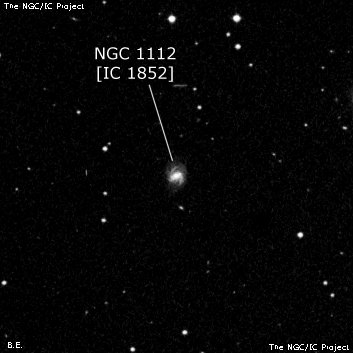
Stephane Javelle discovered IC 1852 = J. 3-956, along with IC 1846 and 1850, on 7 Jan 1896. His position is a good match with UGC 2293 = PGC 10660. Harold Corwin suggests that NGC 1112, found by Marth in 1863, refers to this galaxy though his position 1 min of RA further east. Marth's positions for NGC 1109, 1111, 1112, 1113, 1117 are all off in RA, so this identification is not definite but very possible. See my notes, Corwin's notes and Courtney Seligman's website entry for NGC 1109.
Albert Marth discovered NGC 1112 = m 77 on 2 Dec 1863 with Lassell's 48" on Malta and logged "F, pS". This is the third in a group of 8 galaxies he discovered that night, several of which NGC 1109, 1111, 1112, 1113, 1117) have identification problems because of poor positions or possibly he confused faint stars as nebulous.
Harold Corwin suggests NGC 1112 may refer IC 1852 = UGC 2293 = PGC 10660. Stephane Javelle discovered this galaxy on 7 Jan 1896 with the 30-inch refractor at the Nice Observatory. Marth's position is exactly 1.0 min of RA following IC 1852 and matches in declination. CGCG, UGC and MCG label this galaxy IC 1852, while RNGC, PGC, RC3 and Megastar identify it as NGC 1109. RNGC classifies NGC 1112 as nonexistent. Finally, HyperLEDA equates IC 1852 with NGC 1109. Although NGC 1112 = IC 1852 is a reasonable match, given all the problems in this region this identification is very uncertain. See Corwin's notes for NGC 1109 and Courtney's Seligman website for NGC 1112.
400/500mm - 17.5" (1/9/99): very faint, fairly small, ~40"x25". Appears as a very low surface brightness glow with no noticeable concentration and an ill-defined edge. After extended viewing could hold continuously with direct vision. IC 1850 = NGC 1111: lies 5.6' NW and IC 1846 = NGC 1109: is 19' W. The NGC identification is very uncertain due to a poor position from Marth. This galaxy is identified as IC 1852 in CGCG, UGC and MCG and identified as NGC 1109 in RNGC and RC3.
Notes by Steve Gottlieb